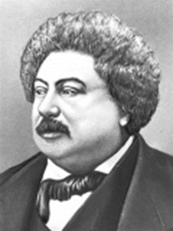Dumas Alexandre

Alexandre Dumas père (b. July 24, 1802, Villers-Cotterêts, Aisne department, France – d. December 5, 1870, Dieppe, Seine-Maritime department, France) was a French novelist and playwright (“charming storyteller”, as H. Balzac called him).
His plays played an important role in the history of French romantic theatre. Dumas received worldwide recognition for his adventure and historical novels: The Three Musketeers (1844), Twenty Years After (1845), The Vicomte of Bragelonne: Ten Years Later (1848–1850), The Count of Monte Cristo (1845–1846), Queen Margot (1845) and etc.
Dumas became famous in Georgia during his lifetime, largely due to his travels to Caucasus. Even before leaving for the Caucasus, in 1858, he published the so-called Causeries in his newspaper “Monte-Cristo”, in which he informed the reader of his intention to see the rock in the Caucasus where Prometheus was chained, and to personally meet Shamil.
He fulfilled his intention that same year, arriving in Georgia on November 23 and staying until January 11, 1859. He described what he saw and experienced in Georgia in his famous book Le Caucase: Impressions de voyage; suite de en Russie. Just after Dumas' arrival, the magazine “Tsiskari” published a report about the visit of the prominent French writer. In addition, the editorial team promised readers that the translation of The Count of Monte Cristo would be published in the near future.
Dumas visited almost all of Georgia: he was in Kartli, Kakheti, Imereti, Samegrelo, and stayed for a long time in Tbilisi, Kutaisi, and Poti. He met prominent figures and writers of the time, learned about Georgian people, their customs and traditions. Dumas wrote that he had found himself in a real “Georgian paradise”.
Dumas was invited to the editorial office of the magazine “Tsiskri”, where a dinner was held, which was attended by the elite of the time.
In his above-mentioned book, Dumas often used Georgian words, expressions, and explained names in French. Overall, it contains many interesting references. The book has been published in Georgian several times.
Translations of Dumas' works in Georgia began during the writer's lifetime. Today, almost all of his best novels have been translated into Georgian. During his travel to Russia and the Caucasus, Dumas was accompanied by the French artist Moine, who made many interesting sketches. While in Tbilisi, Dumas lived in Zubalashvili's house near the current Georgian Museum of Art.
Literary works: OEuvres complètes, v. 1–301, P., [1846–68]; Théâtre complet, v. 1–15, P., 1863–74; Избр. соч., т. 1–8, Л., 1928–29; სამი მუშკეტერი, თბ., 1960; გრაფი მონტე კრისტო, ნაწ. 1–2, თბ., 1962; კავკასია (წინასიტყვ. ა. გაწერელიასი), თბ., 1964.
Literature: ფანჩულიძე დ., ალექსანდრე დიუმა საქართველოში, წგ.: ქართულ-ფრანგული ლიტერატურული ურთიერთობის ისტორიისათვის, თბ., 1969.
G. Buachidze


